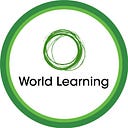Johannesburg — Lessons from History
By Sean Jones
After a long and sleepy bus ride from the wilds of Kruger Park, fellows in the The Fellowship Initiative (TFI) program arrive in Johannesburg, the final stop in their Experiment in International Living journey through South Africa. Johannesburg is the country’s largest and wealthiest metropolitan area; born in a frenzy after the discovery of gold on a nearby farm in 1884, it became one of the fastest growing cities in the world — home to over 100,000 people just ten years after its founding, and to nearly 8 million today. Fellows are in Johannesburg to learn about the city’s rocky evolution from a mining-fueled boomtown, to a severe example of apartheid’s injustices, to a turbulent hotbed of black resistance — to today, when the city is experiencing a rebirth fueled by a diverse movement of young artists and entrepreneurs.
During their first day in Johannesburg, fellows visit Soweto, a sprawling shanty town outside the city that served as a residential area for black miners during the city’s early years and one of the few areas that blacks were permitted to live during apartheid. The impoverished but prideful township was most famously the site of 1976’s 20,000-student Soweto uprising, one of the most iconic and tragic mass protests of the apartheid era, during which up to 700 protestors were killed by police. Fellows see the memorial to Hector Pieterson, the first student to be killed during the uprising — he was 13 years old. Mike, a fellow from Los Angeles, reflects: “It is a lot to take in…I’m 17 years old, I could have been there. I can’t imagine myself in their shoes.”
Students also visit the Apartheid Museum, exploring what it meant to be a black person in South Africa during the twentieth century — from the country’s descent into racial hatred and exclusion, to its tortured but inspiring path towards equal representation. Fellows find a recreation of Mandela’s cell and marvel that they were on Robben Island just days ago looking at the real thing. They are moved by the museum’s profiles of resistance leaders and by videos of youth protests. “I am not used to coming to museums,” says Mike, “but this one hit home. [Resistance leaders] used their words and their education to overcome, which is powerful.”
Outside, fellows linger on the museum steps. Some are overwhelmed by the history of racial discrimination, and its endless reverberations on modern-day issues, but many are inspired by the power of youth resistance. “I want to do something,” says one, “but it is just so much.” Another reflects, “It reminds me of police issues in the states, and Black Lives Matter; people are marching together and staying focused on their goals.” “I think about being successful in college,” says one, “because that is what they fought for, and we must follow through on the dream.”
Today’s young leaders in Johannesburg are finding different ways to make their mark — as entrepreneurs, graffiti artists, and more. Fellows catch a glimpse of the city’s future during a stop in the neighborhood of Newtown, where they talk with a variety of young creatives who are opening coffee shops, making music, designing clothes, and more. Adrian, a Los Angeles fellow, marvels at how the city is “giving permission to young artists to create graffiti and stay out of bad things,” and deploying “art as a countermeasure against negativity.” “No matter what type of tragedies you face,” he says, “there is always hope.”
Fellows are heading from their city tour to cap off their Experiment journey over several intensive days at Johannesburg’s African Leadership Academy. There, they will synthesize all of their leadership lessons from their time in the country, and will make specific plans for leading positive social change projects in their home communities. Check out the next blog to learn about their inspiring project plans.
Sean Jones is director of foundation relations and philanthropic partnerships at World Learning.
